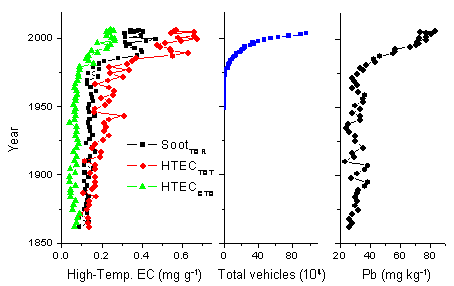Elemental carbon (EC, also called black carbon) in the atmosphere absorbs light and plays a role in Earth radiative balance and climate change. EC is not a well-defined constituent, but a collective term referring to a “combustion continuum”, ranging from slightly charred, degradable biomass to highly condensed, refractory soot. EC can be formed fundamentally by two pathways: the pyrolysis of fuel (EC in char) and gas-phase processes (EC in soot). The two constituents have different physical and chemical properties, as well as the consequent optical characteristics. However, previous studies did not differentiate between char and soot, which limits the better understanding of their environmental and climatic impacts.
Recently, Dr. Yongming Han and his co-workers at Institute of Earth Environment, Chinese Academy of Sciences (IEECAS) applied the thermal optical reflectance (TOR) method, the most popular method for carbonaceous aerosol measurement, for measuring EC in sediments and soils (Han et al., 2007, Chemosphere, 69, 526-533). This facilitates the comparison of the very short atmospheric EC time series to longer sedimentary EC records using the same method. Meanwhile, as TOR has an advantage of stepwise oxidation of different carbon fraction under different temperatures and atmosphere, Han et al. (2007, Chemosphere, 69, 569-574) suggest that it can be used to separate soot from char. This differentiation has been used in aerosol studies to explore the different characteristics of char and soot in the atmosphere (Han et al., 2010, Atmospheric Chemistry and Physics, 10, 595-607). However, the effectiveness of this method on the reconstruction of EC pollution history in lake sediments has not been tested.
In their latest study Dr. Han and his co-workers compared the TOR method with another two popular methods, the thermal optical transmittance (TOT) and chemothermal oxidation (CTO), and measured EC in 150 yr sediments collected from Lake Chaohu in Anhui Province, eastern China. The comparison of the three methods shows that the distribution patterns for EC concentrations are different among the three methods, most likely due to the operational definition of EC and different temperature treatments prescribed for each method. However, similar profiles were found for high-temperature EC fractions among different methods, and the profiles are similar to the lead profile (Han et al., 2011, Journal of Environmental Monitoring, 13, 743-752) and consistent with the history of motor vehicle emissions, suggesting that high-temperature thermal protocols are suitable for differentiating between soot and other forms of carbon in lake sediments. Similar soot record was also obtained from Lake Taihu (~200 km away), suggesting a regional source of soot redistributed via the atmosphere. A new indication of the ratio of char to sootwas used for source identification, which shows an overall decreasing trend in the past 150 years in Lake Chaohu, consistent with gradual changes in fuel use from wood burning to increasing fossil fuel combustions. This work is published in an international journal Environmental Science & Technology (Han et al., 2011, 45, 5287-5293).

 © 2015 Institute of Earth Environment,CAS
© 2015 Institute of Earth Environment,CAS Address:No. 97 Yanxiang Road, Xi'an 710061, Shaanxi, China

 Location :
Location :